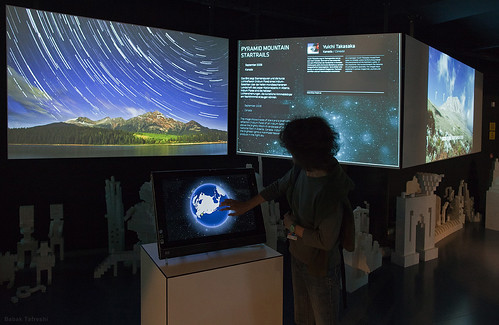
I’m a photography enthusiast, so of course my favorite installation is the TWAN Globe in GeoCity. A touchscreen lets users rotate the sphere bristling with digital pins that mark the spots on our planet’s surface where the shots that make up “The World at Night” exhibition were taken. There are 84 of them, each one spectacular—so plan on spending some time here.
Since time immemorial, humankind has been fascinated by gazing at the starry night sky. The 17,000-year-old images of the zodiac painted on the walls of the Lascaux Caves attest to this. I find it particularly interesting that the very first photograph—the 1843 exposure by Louis Daguerre, the inventor of photography—is a picture of the Moon. Now, modern technology makes it possible to create incredibly high-resolution images of the heavens.
I’m fascinated by the aesthetic photographs contributed to “The World at Night” by photographers from all over our world. But in addition to creating images that are things of beauty in and of themselves, the photographers also wanted to call attention to light pollution in our cities and to sensitize people to the fact that viewing the night sky is humankind’s heritage. Beholding it is rewarding indeed!
More about the exhibition „The World at Night“
 As an infotrainer, Flora Fellner has been conducting tours of the AEC since March 2011. She’s an on-site source of authoritative information about the exhibits. While majoring in European ethnology at college, Flora studied numerous aspects of the culture of everyday life. So, not surprisingly, it’s precisely this aspect of her work in the museum—how new technologies are changing everyday life and the things people utilize in conjunction with it—that she finds most fascinating. She especially appreciates the many interesting conversations she gets into with visitors and colleagues.
As an infotrainer, Flora Fellner has been conducting tours of the AEC since March 2011. She’s an on-site source of authoritative information about the exhibits. While majoring in European ethnology at college, Flora studied numerous aspects of the culture of everyday life. So, not surprisingly, it’s precisely this aspect of her work in the museum—how new technologies are changing everyday life and the things people utilize in conjunction with it—that she finds most fascinating. She especially appreciates the many interesting conversations she gets into with visitors and colleagues.
